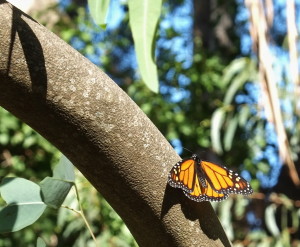 A fall or winter visit to Natural Bridges is like an annual ritual to see the monarchs.
A fall or winter visit to Natural Bridges is like an annual ritual to see the monarchs.
Planned or unplanned, we somehow end up here almost every year. Some years have fewer monarchs, but this October was already bright with butterflies!
We took more time to enjoy the grove and museum, learned about milkweed and got some seeds to spread the monarchs magic!
Monarch Magic at Natural Bridges State Beach
Natural Bridges hosts Welcome Back Monarchs Day
- What do Monarch Butterflies Eat?
- Do the monarch butterflies need nectar?
- How often must a monarch drink?
- How do you tell the difference between a male and a female monarch?
- What is the minimum temperature needed for a butterfly to fly?
- A butterfly suns itself to be warm enough to fly. What part of the body helps to do this?
- Why do these monarchs spend the winter along the coast?
- How long do the monarch butterfly live?
- How far does a monarch fly each day while migrating South?
- Why do monarchs migrate?
- Is there also a Northern migration?
- The monarchs come to these particular eucalyptus trees each year. What do they like about these trees?
- Why do monarch butterflies cluster?
Monarch caterpillars eat ONLY milkweed. They receive all their body fat for growth at this stage.
Not if they have an adequate amount of lipids (body fat) for the winter, but they will sip nectar if it is available.
About once a week.
The males have a spot on each hind wing easily seen on the upper side of the wing. The females do not have the spot, and their black lines (veins) are wider than the males.
Fifty five degrees Fahrenheit to fly.
Forty five degrees Fahrenheit to move.
The wings. They act as solar panels. To fly, a butterfly’s body temperature needs to be at least 55 degrees Fahrenheit.
The weather here is cold enough that the monarch butterfly can go into reproductive diapause (similar to hibernation), but not cold enough to freeze (something that would kill a butterfly).
These monarchs are the lucky ones. They are born in the fall and live 6 to 9 months. The monarchs that are born in the spring and summer live about 2 months. There may be 5 to 6 generations of monarchs in a year.
Depending on the weather conditions, they can fly 60 to 100 miles a day. Those on the west coast must fly against the winds. On the east side of the continental divide, they are helped by the wind. This generation migrates South.
Monarchs are tropical butterflies. At no time in their life (egg, caterpillar, chrysalis, or butterfly) can they freeze, so the butterflies move with the warm weather.
Not really. The monarchs follow the milkweed patches North as the weather gets warmer. Each generation flies a little farther North to egg their eggs, and then dies. Following generations repeat the cycle until the temperature and daylight start to decrease.
This eucalyptus grove is located in a canyon providing the monarchs with a shelter from the wind and filters sunlight to keep their bodies from freezing. These trees also flower in the winter, giving the butterflies a convenient source of food.
Clustering may help in protecting the butterfly from wind and rain. Clustering may also make it easier to find a mate, as the male scent gland no longer functions in the monarchs.

Pingback: BOOK: Butterflies on Carmen Street | C I T I N E R A R I E S